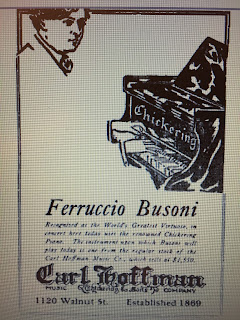Now, I will be honest that other than having heard his name, I knew little, if anything, about Busoni. So I looked him up and learned that he lived from 1866-1924. He was one of the greatest pianists of his time. He knew Liszt, Brahms, and Rubinstein. He was also a prolific composer, arranger, transcriber, conductor and teacher. He toured extensively, and found his way to Sedalia, Missouri. But when?
I live only about an hour from Sedalia, and on my my home from a work trip to St. Louis this weekend, I stopped at the library in Sedalia hoping to learn more about his visit. I googled the calendars for the years 1911, and 1916, and March 10 was a Friday in both of those years. Someone had already figured that out and that's why it was written on the card. So when I got to the library, I asked the librarian for the 1911 and 1916 Sedalia Democrat-Sentinel newspapers. They are on microfiche, and she disappeared for a few minutes to locate them. She returned with 2 boxes and we sat down to load them onto the reader. We started with 1911. In a few minutes I saw this:
So I knew it was 1911, and as I flipped through the pages, I arrived at this:
Another promotion, this time with his picture and full name: Ferruccio Benvenuto Michel Angelo Dante Busoni.
And then a bit later I found the review of his performance, published Sunday, March 12, 1911:
TRULY A MUSICAL TREAT
_______
The Great Busoni at Sedalia Theater Friday Night
_______
One of the greatest triumphs that the Ladies' Musical club has ever achieved was the giving to Sedalia music lovers the opportunity of hearing the world renowned pianist Ferruccio Busoni, Friday night. And right well did the Sedalia public support the ladies in their effort, for never was there in the new theater a more representative assembly, and Mr. Busoni said he had rarely played to a more appreciative, attentive or beautiful audience.
Sedalia society was out in force, and the ladies in the audience and boxes never presented a handsomer appearance. The surrounding towns sent large delegations-Warrensburg, Columbia, Boonville, Tipton, Cole Camp, Damonte, and Fayette were represented.
The heads of the musical departments of the various colleges were all here, showing their appreciation of the rare opportunity of hearing so great an artist.
Of Busoni too much cannot be said in his praise. The critics have united in pronouncing him the greatest pianist now living, and it would be fulsome to try to add to what has already been written of the wonderful genius of this wizard of the piano forte.
He first played the great masterful Waldstren sonata (the reviewer meant Beethoven's Sonata no. 21 in C major, "Waldstein.") filled with soul melodies, then showed his mighty skill, technique and mastery of the piano in the Brahms-Paganini variations, and followed this with the tender, beautiful C minor Chopin Nocturne and the great Polonaise by the same master. His last group was made up of the beautiful Campanella, the Erl King and Rigoletto-all transcriptions by Liszt, and in these he had opportunity for showing every requirement which goes to make up the great pianist, and in each and every one he was all that could be desired.
His audience sat spellbound and the only regret expressed was that Mr. Busoni did not respond to the enthusiastic encore which the audience demanded after every number. But this was owing to the fact that that for several days he had been very ill and at 4 o'clock in the afternoon he feared he would not be able to fill his engagement that night, and at the close of his program was so prostrated that he was physically unable to play again, and expressed regret that he could not do so for an audience which was so sympathetic and appreciative.
Mr. Busoni has a reputation of being one of the most generous of the great artists with regard to giving encores and it was only because he was ill and unable to do so that he did not respond to the enthusiasm of the audience Friday night.
From every point of view the Busoni concert was a grand success, and the Ladies' Musical club is again to be congratulated upon another musical and artistic triumph.
________
I've done some more research and found out that Busoni played in Kansas City in 1915. I don't have the review yet, but I will try and find it soon. But I found found this advertisement in The Piano Trade Magazine, Volume 12 (1915):
The caption below this reads "This is an advertisement put out by the Carl Hoffman Music Company sometime ago when Busoni played the Chickering in concert in Kansas City." Looks like Carl Hoffman was at 1120 Walnut Street. The postcard above for the Sedalia recital also mentions that Busoni was playing on a Chickering piano there as well.







